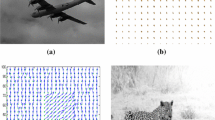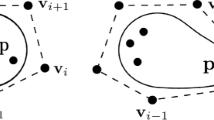Abstract
Traditionally, image blurring by diffusion is done in Euclidean space, in an image-based coordinate system. This will blur edges at object boundaries, making segmentation difficult. Geometry-driven diffusion 1 uses a geometric model to steer the blurring, so as to blur along the boundary (to overcome noise) but edge-detect across the object boundary. In this paper, we present a scale-space on image profiles taken about the object boundary, in an object-intrinsic coordinate system. The profiles are sampled from the image in the fashion of Active Shape Models 2, and a scale-space is constructed on the profiles, where diffusion is run only in directions tangent to the boundary. Features from the scale-space are then used to build a statistical model of the image structure about the boundary, trained on a population of images with corresponding geometric models. This statistical image match model can be used in an image segmentation framework. Results are shown in 2D on synthetic and real-world objects; the methods can also be extended to 3D.
Supported by NIH-NCI P01 CA47982.
Access this chapter
Tax calculation will be finalised at checkout
Purchases are for personal use only
Preview
Unable to display preview. Download preview PDF.
Similar content being viewed by others
References
Bart M. ter Haar Romeny, Ed., Geometry-Driven Diffusion in Computer Vision, Computational Imaging and Vision. Kluwer Academic Publisher, 1994.
Timothy F. Cootes, A. Hill, Christopher J. Taylor, and J. Haslam, “The use of active shape models for locating structures in medical images,” in IPMI, 1993, pp. 33–47.
J.F. Canny, “A computational approach to edge detection,” IEEE Trans on Pattern Analysis and Machine Intelligence (PAMI), vol. 8, no. 6, pp. 679–697, November 1986.
P. Perona and J. Malik, “Scale-space and edge detection using anisotropic diffusion,” IEEE Trans on Pattern Analysis and Machine Intelligence (PAMI), vol. 12, no. 7, pp. 629–639, July 1990.
N. Sochen, R. Kimmel, and R. Malladi, “A general framework for low level vision,” IEEE Transactions on Image Processing, vol. 7, no. 3, pp. 310–318, 1998.
Bei Tang, Guillermo Sapiro, and Vicent Caselles, “Diffusion of general data on non-flat manifolds via harmonic maps theory: The direction diffusion case,” International Journal of Computer Vision (IJCV), vol. 36, no. 2, pp. 149–161, 2000.
M.K. Chung, K.J. Worsley, J. Taylor, J.O. Ramsay, S. Robbins, and A.C. Evans, “Diffusion smoothing on the cortical surface,” NeuroImage, vol. 13S, no. 95, 2001.
András Kelemen, Gábor Székely, and Guido Gerig, “Elastic model-based segmentation of 3d neuroradiological data sets,” IEEE Transactions on Medical Imaging (TMI), vol. 18, pp. 828–839, October 1999.
Timothy F. Cootes, Gareth J. Edwards, and Christopher J. Taylor, “Active appearance models,” IEEE Transactions on Pattern Analysis and Machine Intelligence (PAMI), vol. 23, no. 6, pp. 681–685, 2001.
L.H. Staib and J.S. Duncan, “Boundary finding with parametrically deformable contour models,” IEEE Transactions on Pattern Analysis and Machine Intelligence (PAMI), vol. 14, no. 11, pp. 1061–1075, Nov 1992.
M. Leventon, O. Faugeraus, and W. Grimson, “Level set based segmentation with intensity and curvature priors,” in Workshop on Mathematical Methods in Biomedical Image Analysis Proceedings (MMBIA), June 2000, pp. 4–11.
L. M. J. Florack, B. M. ter Haar Romeny, J. J. Koenderink, and M. A. Viergever, “The Gaussian scale-space paradigm and the multiscale local jet,” International Journal of Computer Vision (IJCV), vol. 18, no. 1, pp. 61–75, April 1996.
G. Székely, A. Kelemen, Ch. Brechbühler, and G. Gerig, “Segmentation of 2-D and 3-D objects from MRI volume data using constrained elastic deformations of flexible Fourier contour and surface models,” Medical Image Analysis, vol. 1, no. 1, pp. 19–34, 1996.
A. Hyvärinen, J. Karhunen, and E. Oja, Independent Component Analysis, John Wiley & Sons, New York, 2001.
SM Pizer, T Fletcher, A Thall, M Styner, G Gerig, and S Joshi, “Object models in multiscale intrinsic coordinates via m-reps,” in Generative-Model-Based Vision (GMBV), 2002.
Conglin Lu, Stephen M. Pizer, and Sarang Joshi, “A markov random field approach to multi-scale shape analysis,” in ScaleSpace, 2003, vol. this volume.
Author information
Authors and Affiliations
Editor information
Editors and Affiliations
Rights and permissions
Copyright information
© 2003 Springer-Verlag Berlin Heidelberg
About this paper
Cite this paper
Ho, S., Gerig, G. (2003). Scale-Space on Image Profiles about an Object Boundary. In: Griffin, L.D., Lillholm, M. (eds) Scale Space Methods in Computer Vision. Scale-Space 2003. Lecture Notes in Computer Science, vol 2695. Springer, Berlin, Heidelberg. https://doi.org/10.1007/3-540-44935-3_39
Download citation
DOI: https://doi.org/10.1007/3-540-44935-3_39
Published:
Publisher Name: Springer, Berlin, Heidelberg
Print ISBN: 978-3-540-40368-5
Online ISBN: 978-3-540-44935-5
eBook Packages: Springer Book Archive




